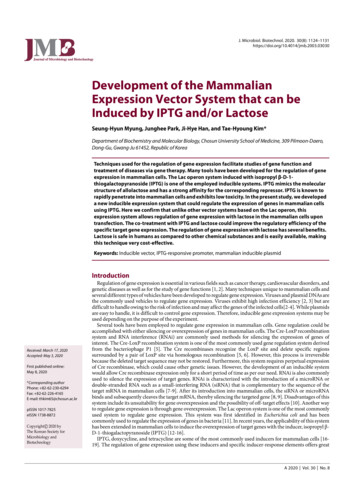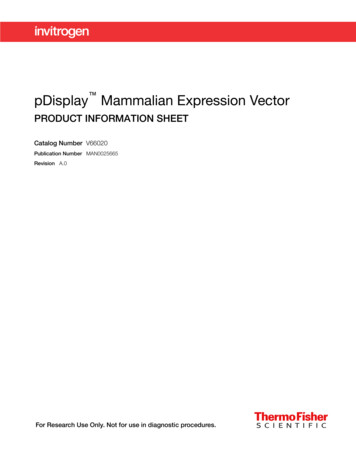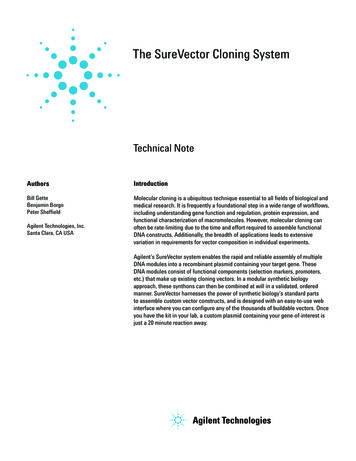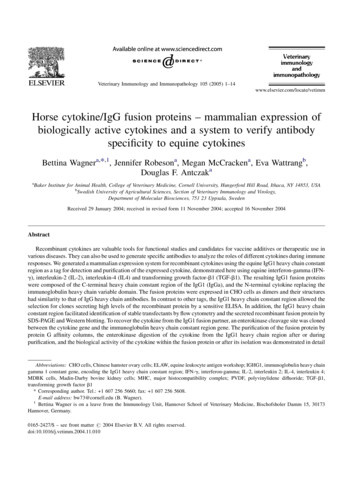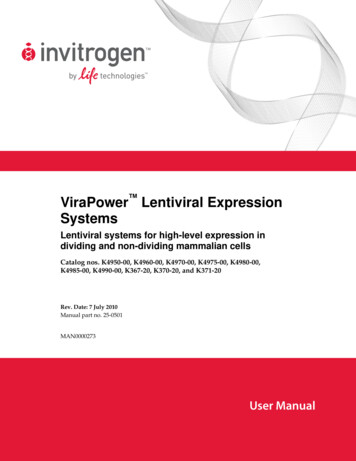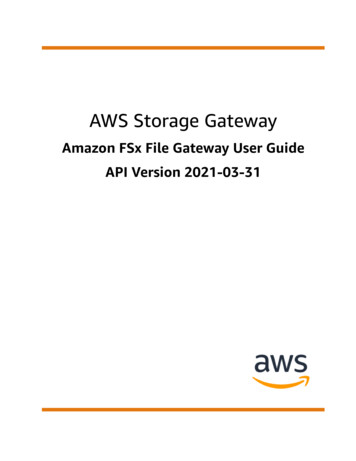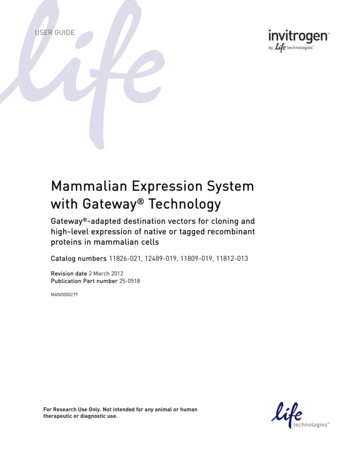
Transcription
user guideMammalian Expression Systemwith Gateway TechnologyGateway -adapted destination vectors for cloning andhigh-level expression of native or tagged recombinantproteins in mammalian cellsCatalog numbers 11826-021, 12489-019, 11809-019, 11812-013Revision date 2 March 2012Publication Part number 25-0518MAN0000279For Research Use Only. Not intended for any animal or humantherapeutic or diagnostic use.
ii
ContentsKit Contents and Storage. vIntroduction . 1Product Overview . 1Experimental Outline . 3Methods. 4Generating an Entry Clone . 4Creating an Expression Clone . 6Performing the LR Recombination Reaction . 9Transforming Library Efficiency DH5α Cells .11Analyzing Transformants .12Transfection .13Expression and Analysis .14Generating Stable Cell Lines .15Purifying the Recombinant Protein .16Appendix . 17Map and Features of pcDNA 3.2/V5-DEST .17Map and Features of the pDEST 26 and pDEST 27 Vectors .19Map of pENTR -gus .22Accessory Products .23Technical Support .25Purchaser Notification .26Gateway Clone Distribution Policy .27References .28iii
iv
Kit Contents and StorageTypes of ProductsThis manual is supplied with the following products.ProductCat. no.Mammalian Expression System with Gateway Technology 11826-021 Gateway pcDNA 3.2/V5-DEST Vector12489-019 11809-019 11812-013Gateway pDEST 26 VectorGateway pDEST 27 VectorThe pcDNA 3.2/V5-DEST Vector has been renamed from pcDNA 3.2-DEST to bemore descriptive and to better reflect the functionality of the vector.Kit ComponentsEach product contains the following components. For a detailed description of thecontents of each component, see the next page.Cat. no.ComponentpcDNA 3.2/V5-DEST Vector 12489-019 11809-019 pDEST 26 Vector 11812-013 pDEST 27 Vector Gateway LR Clonase II Enzyme Mix Library Efficiency DH5α CompetentE. coliShipping andStorage11826-021 The Mammalian Expression System with Gateway Technology is shipped asdescribed below. Upon receipt, store each item as detailed below.BoxItem1Destination Vectors2 3Shipping Gateway LR Clonase II Enzyme Mix Library Efficiency DH5α CompetentE. coliStorageRoom temperature–20 CDry ice–20 CDry ice–80 CNote: The individual Gateway destination vectors (Cat. nos. 12489-019, 11809-019, and11812-013) are shipped at room temperature. Upon receipt, store at –20 C.For research use only. Not intended for any human or animal therapeutic ordiagnostic use.Continued on next pagev
Kit Contents and Storage, ContinuedDestinationVectorsThe following destination vectors (Box 1) are supplied with the MammalianExpression System with Gateway Technology. Store the vectors at –20 C.Note: Cat. nos. 12489-019, 11809-019, and 11812-013 contain 6 μg of the appropriatedestination vector only.ReagentComposition pcDNA 3.2/V5-DEST Vector150 ng/μL in 10 mM Tris-HCl, 1 mM EDTA,pH 8.0 in a total volume of 40 μL6 μgpDEST 26 Vector150 ng/μL in 10 mM Tris-HCl, 1 mM EDTA,pH 8.0 in a total volume of 40 μL6 μgpDEST 27 Vector150 ng/μL in 10 mM Tris-HCl, 1 mM EDTA,pH 8.0 in a total volume of 40 μL6 μgLR Clonase IIEnzyme MixThe following reagents are included with the Gateway LR Clonase II Enzyme Mix(Box 2). Store Box 2 at –80 C for up to 6 months. For long-term storage, store at -80 C.Reagent DH5α Competent E. coli CompositionviAmountGateway LR Clonase II Enzyme MixProprietary40 μLProteinase K Solution2 μg/μL in:10 mM Tris-HCl, pH 7.520 mM CaCl250% glycerol40 μLpENTR -gus Positive Control50 ng/μL in TE Buffer, pH 8.020 μLThe Library Efficiency DH5α Competent E. coli kit (Box 3) includes the followingitems. Transformation efficiency is 1 108 cfu/μg DNA. Store Box 3 at –80 C.ItemCompositionS.O.C. Medium(may be stored at room temperature or 4 C)2% tryptone0.5% yeast extract10 mM NaCl2.5 mM KCl10 mM MgCl210 mM MgSO420 mM glucoseLibrary Efficiency Chemically Competent DH5α –pUC19 Control DNA10 pg/μL in 5 mM Tris-HCl,0.5 mM EDTA, pH 8Genotype ofDH5α AmountF- recA1 endA1 hsdR17(rk-, mk ) supE44 λ- thi-1 gyrA96 relA1Amount2 6 mL5 200 μL50 μL
IntroductionProduct OverviewDescription of theSystemThe Mammalian Expression System with Gateway Technology contains a seriesof Gateway -adapted destination vectors designed to facilitate high-levelexpression of recombinant proteins in mammalian cells. Depending on the vectorchosen, the destination vectors allow production of native, N-terminal, orC-terminal-tagged recombinant proteins (see table below).Vector pcDNA 3.2/V5-DESTFusion PeptideFusion TagC-terminalV5 epitope (Southern et al., 1991) N-terminal6xHis N-terminalGlutathione S-transferase (GST)(Smith et al., 1986)pDEST 26pDEST 27For more information about the Gateway Technology, see the next page.Features of theVectorspcDNA 3.2/V5-DEST, pDEST 26, and pDEST 27 contain the following elements: The human cytomegalovirus (CMV) immediate early enhancer/promoter forhigh-level, constitutive expression of the gene of interest in a wide range ofmammalian cells (Andersson et al., 1989; Boshart et al., 1985; Nelson et al.,1987) N-terminal or C-terminal fusion tags for detection and purification ofrecombinant fusion proteins (choice of tag depends on the particular vector;see above) Two recombination sites, attR1 and attR2, downstream of the CMV promoterfor recombinational cloning of the gene of interest from an entry clone Chloramphenicol resistance gene (CmR) located between the two attR sites forcounterselection The ccdB gene located between the attR sites for negative selection Neomycin resistance gene for selection of stable cells lines using Geneticin (Southern and Berg, 1982) Ampicillin resistance gene for selection in E. coli pUC origin for high-copy replication and maintenance of the plasmid in E. coli1
Product Overview, ContinuedThe Gateway TechnologyThe Gateway Technology is a universal cloning method that takes advantage ofthe site-specific recombination properties of bacteriophage lambda (Landy, 1989)to provide a rapid and highly efficient way to move your gene of interest intomultiple vector systems. To express your gene of interest in mammalian cellsusing the Gateway Technology, simply:1.Clone your gene of interest into a Gateway entry vector of choice to create anentry clone.2.Perform an LR recombination reaction between the entry clone and aGateway destination vector (e.g. pcDNA 3.2/V5-DEST, pDEST 26, orpDEST 27).3.Transform Library Efficiency DH5α E. coli and select for an expressionclone.4.Purify plasmid and transfect your expression clone into the mammalian cellline of choice.For detailed information about the Gateway Technology, refer to the Gateway Technology with Clonase II manual. To generate an entry clone, refer to themanual for the entry vector you are using. The Gateway Technology withClonase II manual and entry vector manuals are available for downloading fromwww.lifetechnologies.com/support or by contacting Technical Support (seepage 25).LR Recombination You will perform an LR recombination reaction between the entry clone and yourdestination vector of choice to generate an expression clone. The LRReactionrecombination reaction is mediated by LR Clonase II enzyme mix, a mixture ofthe bacteriophage λ Integrase (Int) and Excisionase (Xis) proteins, and the E. coliIntegration Host Factor (IHF) protein. For more information about the LRrecombination reaction, see the Gateway Technology with Clonase II manual.2
Experimental OutlineExperimentalOutlineThe table below outlines the steps required to express your gene of interest inmammalian cells from pcDNA 3.2/V5-DEST, pDEST 26, or pDEST 27.StepActionPage1Design an appropriate scheme and clone your gene ofinterest into the Gateway entry vector of choice togenerate an entry clone.4–82Perform an LR recombination reaction by mixing theentry clone and the appropriate destination vector withGateway LR Clonase II enzyme mix.9–103Transform the recombination reaction into competentLibrary Efficiency DH5α cells and select forexpression clones.114Analyze transformants for the presence of insert byrestriction enzyme digestion or colony PCR.125Optional: Sequence to confirm that the gene of interestis cloned in frame with the appropriate N-terminal orC-terminal tag126Prepare purified plasmid DNA and transfect themammalian cell line of choice. Generate a stable cellline, if desired.7Assay for expression of your recombinant protein.148Purify your recombinant protein, if desired.1613, 153
MethodsGenerating an Entry CloneIntroductionTo recombine your gene of interest into pcDNA 3.2/V5-DEST, pDEST 26, orpDEST 27, you will need an entry clone containing the gene of interest. Manyentry vectors are available to facilitate generation of entry clones (see tablebelow). For more information about each vector, seewww.lifetechnologies.com/support or contact Technical Support (see page 25).Entry Vector pENTR /D-TOPO Cat. no. K2400-20 pENTR /SD/D-TOPO K2420-20pENTR 1A11813-011pENTR 2B11816-014 11817-012 11818-010 11819-018pENTR 3CpENTR 4pENTR 11Once you have selected an entry vector, refer to the manual for the specific entryvector you are using for instructions to construct an entry clone. All entry vectormanuals are available for downloading from www.lifetechnologies.com/supportor by contacting Technical Support (see page 25).If you wish to express a human gene of interest in pcDNA 3.2/V5-DEST,pDEST 26, or pDEST 27, you may want to use an Ultimate Human ORF(hORF) Clone available for ordering. The Ultimate hORF Clones are fullysequenced clones provided in a Gateway entry vector that is ready-to-use in anLR recombination reaction with the destination vector. For more informationabout the Ultimate hORF Clones available, see www.lifetechnologies.com orcontact Technical Support (see page 25).Continued on next page4
Generating an Entry Clone, ContinuedPoints to Consider pcDNA 3.2/V5-DEST is a C-terminal fusion vector; however, you may use thisvector to express native proteins or C-terminal fusion proteins.BeforeRecombining into Your gene of interest in the entry clone must contain an ATG initiationpcDNA 3.2/V5codon within the context of a Kozak consensus sequence for properDESTinitiation of translation (Kozak, 1987; Kozak, 1991; Kozak, 1990). An exampleof a Kozak sequence is (G/A)NNATGG. The ATG initiation codon isunderlined. Note that other sequences are possible, but the G or A atposition –3 and the G at position 4 are the most critical for function (shownin bold). If you wish to include the V5 epitope tag, your gene in the entry cloneshould not contain a stop codon. In addition, the gene should be in framewith the V5 epitope tag after recombination. If you do not wish to include the V5 epitope tag, make sure that your genecontains a stop codon in the entry clone.Refer to the diagram of the recombination region of pcDNA 3.2/V5-DEST onpage 7 to help you design a strategy to generate your entry clone.Points to ConsiderBeforeRecombining intopDEST 26 andpDEST 27pDEST 26 and pDEST 27 are N-terminal fusion vectors and contain an ATGinitiation codon within the context of a Kozak consensus sequence upstream ofthe 6xHis and GST tags, respectively. Your gene of interest in the entry clonemust: Be in frame with the N-terminal tag after recombination. Contain a stop codon.Refer to the diagram of the pDEST 26 or pDEST 27 recombination region onpage 7 or 8, respectively, to help you design a strategy to generate your entryclone.5
Creating an Expression CloneIntroductionAfter you have generated an entry clone, you will perform the LR recombinationreaction to transfer the gene of interest into the pcDNA 3.2/V5-DEST,pDEST 26, or pDEST 27 vector to create your expression clone. To ensure thatyou obtain the best possible results, we recommend that you read this sectionand the next section entitled Performing the LR Recombination Reaction(pages 9–10) before beginning.The pcDNA 3.2/V5-DEST, pDEST 26, and pDEST 27 vectors are supplied assupercoiled plasmids. Although we have previously recommended using alinearized destination vector for more efficient recombination, further testing hasfound that linearization of the destination vector is NOT required to obtainoptimal results for any downstream application.Propagating theVectorsTo propagate and maintain the pcDNA 3.2/V5-DEST, pDEST 26, andpDEST 27 vectors prior to recombination, use the supplied150 ng/mL stocksolution in TE, pH 8.0 to transform One Shot ccdB Survival T1R ChemicallyCompetent E. coli (see page 23 for ordering). The ccdB Survival T1R E. coli strainis resistant to CcdB effects and can support the propagation of plasmidscontaining the ccdB gene. To maintain the integrity of the vector, select fortransformants in media containing 50–100 μg/mL ampicillin and 15–30 μg/mLchloramphenicol.Note: Do not use general E. coli cloning strains including TOP10 or DH5α forpropagation and maintenance as these strains are sensitive to CcdB effects.Continued on next page6
Creating an Expression Clone, ContinuedRecombinationRegion ofpcDNA 3.2/V5DESTThe recombination region of the expression clone resulting frompcDNA 3.2/V5-DEST entry clone is shown below.RecombinationRegion ofpDEST 26The recombination region of the expression clone resulting from pDEST 26 entry clone is shown below.Features of the Recombination Region: Shaded regions correspond to those DNA sequences transferred from theentry clone into the pcDNA 3.2/V5-DEST vector by recombination.Non-shaded regions are derived from the pcDNA 3.2/V5-DEST vector. The underlined nucleotides flanking the shaded region correspond to bases918 and 3161, respectively, of the pcDNA 3.2/V5-DEST vector sequence.Features of the Recombination Region: The location of the 6xHis tag is indicated to help you determine if your genewill be in frame with the 6xHis tag after recombination. Shaded regions correspond to those DNA sequences transferred from theentry clone into the pDEST 26 vector by recombination. Non-shaded regionsare derived from the pDEST 26 vector. The underlined nucleotides flanking the shaded region correspond to bases678 and 2361, respectively, of the pDEST 26 vector sequence. Potential stop codons are indicated in bold.Continued on next page7
Creating an Expression Clone, ContinuedRecombinationRegion ofpDEST 278The recombination region of the expression clone resulting from pDEST 27 entry clone is shown below.Features of the Recombination Region: The glutathione S-transferase (GST) gene is pictured to help you determine ifyour gene will be in frame with the GST tag after recombination. Shaded regions correspond to those DNA sequences transferred from theentry clone into the pDEST 27 vector by recombination. Non-shaded regionsare derived from the pDEST 27 vector. The underlined nucleotides flanking the shaded region correspond to bases1320 and 3003, respectively, of the pDEST 27 vector sequence. Potential stop codons are indicated in bold.
Performing the LR Recombination ReactionIntroductionOnce you have produced an entry clone containing your gene of interest, you areready to perform an LR recombination reaction between the entry clone and theappropriate destination vector, and to transform the reaction mixture into LibraryEfficiency DH5α to select for an expression clone. We recommend that youinclude a positive control (see below) and a negative control (no LR Clonase II) inyour experiment to help you evaluate your results.Positive ControlThe pENTR -gus plasmid is included in the Mammalian Expression System withGateway Technology for use as a positive control for LR recombination andexpression. Using the pENTR -gus entry clone in an LR recombination reactionwith a destination vector will allow you to generate an expression clonecontaining the gene encoding β-glucuronidase (gus).LR Clonase IIEnzyme MixLR Clonase II enzyme mix is supplied with the kit (Cat. no. 11826-021 only) oravailable separately to catalyze the LR recombination reaction (see page 23). TheLR Clonase II enzyme mix combines the proprietary enzyme formulation and 5XLR Clonase Reaction Buffer previously supplied as separate components in LRClonase enzyme mix into an optimized single-tube format for easier set-up of theLR recombination reaction. Use the protocol provided on page 10 to perform theLR recombination reaction using LR Clonase II enzyme mix.Note: You may perform the LR recombination reaction using LR Clonase enzyme mix, ifdesired. To use LR Clonase enzyme mix, follow the protocol provided with the product.Do not use the protocol for LR Clonase II enzyme mix provided in this manual as reactionconditions differ.Materials Needed Purified plasmid DNA of your entry clone (50–150 ng/μL in TE, pH 8.0) Destination vector (150 ng/μL in TE, pH 8.0) LR Clonase II enzyme mix (supplied with the kit, Box 2; keep at –20 C untilimmediately before use) TE Buffer, pH 8.0 (10 mM Tris-HCl, pH 8.0, 1 mM EDTA) Proteinase K solution (supplied with kit, Box 2; thaw and keep on ice untiluse) pENTR -gus positive control (50 ng/μL in TE, pH 8.0; supplied with the kit,Box 2)Continued on next page9
Performing the LR Recombination Reaction, ContinuedSetting Up the LRRecombinationReactionFollow this procedure to perform the LR reaction between your entry clone and thedestination vector. If you want to include a negative control, set up a separatereaction but omit the LR Clonase II enzyme mix.1.Add the following components to 1.5 mL microcentrifuge tubes at roomtemperature and mix.ComponentSamplePositive ControlEntry clone (50–150 ng/reaction)1–7 μL–Destination vector (150 ng/μL)1 μL1 μLpENTR -gus (50 ng/μL)–2 μLTE Buffer, pH 8.0to 8 μL5 μL 2.Remove the LR Clonase II enzyme mix from –20 C and thaw on ice( 2 minutes).3.Vortex the LR Clonase II enzyme mix briefly twice (2 seconds each time).4.To each sample above, add 2 μL of LR Clonase II enzyme mix. Mix well bypipetting up and down.Reminder: Return LR Clonase II enzyme mix to –20 C immediately after use.5.Incubate reactions at 25 C for 1 hour.Note: For most applications, 1 hour will yield a sufficient number of colonies foranalysis. Depending on your needs, the length of the recombination reaction can beextended up to 18 hours. For large plasmids ( 10 kb), longer incubation times will yieldmore colonies.6.Add 1 μL of Proteinase K solution to each reaction. Incubate for 10 minutes at37 C.7.Proceed to Transforming Library Efficiency DH5α Cells, next page.Note: You may store the LR reaction at –20 C for up to 1 week before transformation, ifdesired.10
Transforming Library Efficiency DH5α CellsIntroductionOnce you have performed the LR recombination reaction, you will transformcompetent E. coli. Library Efficiency DH5α chemically competent E. coli (Box 2)are included with the Mammalian Expression System for use in transformation.Materials Needed LR recombination reaction (from Step 7, previous page) Library Efficiency DH5α chemically competent cells (supplied with the kit,Box 3; thaw on ice before use) S.O.C. Medium (supplied with the kit, Box 3; warm to room temperature) pUC19 control (supplied with the kit, Box 3; use as a control fortransformation if desired) LB plates containing 100 μg/mL ampicillin (two for each transformation;warm at 37 C for 30 minutes) 42 C water bath 37 C shaking and non-shaking incubatorLibrary Efficiency DH5α competent cells are supplied in 5 tubes containing0.2 mL of competent cells each. Each tube contains enough competent cells toperform 4 transformations using 50 μL of cells per transformation. Once youhave thawed a tube of competent cells, discard any unused cells. Do notre-freeze cells as freezing and thawing of cells will result in the loss oftransformation efficiency.TransformationProcedure1.For each transformation, aliquot 50 μL of Library Efficiency DH5α competent cells into a sterile microcentrifuge tube.2.Add 1 μL of the LR recombination reaction (from Setting Up the LRRecombination Reaction, Step 7, previous page) into the tube containing50 μL of Library Efficiency DH5α competent cells and mix gently. Do notmix by pipetting up and down.3.Incubate on ice for 30 minutes.4.Heat-shock the cells for 30 seconds at 42 C without shaking.5.Immediately transfer the tubes to ice.6.Add 450 μL of room temperature S.O.C. Medium.7.Cap the tube tightly and shake the tube horizontally (200 rpm) at 37 C for1 hour.8.Spread 20 μL and 100 μL from each transformation on a prewarmed selectiveplate and incubate overnight at 37 C. We generally plate 2 different volumesto ensure that at least 1 plate has well-spaced colonies.9.An efficient LR recombination reaction should produce 5000 colonies if theentire LR reaction is transformed and plated.11
Analyzing TransformantsAnalyzing Positive 1. Pick 5 colonies and culture them overnight in LB or SOB medium containing100 μg/mL ampicillin.ClonesAnalyzingTransformants byPCR2.Isolate plasmid DNA using your method of choice. We recommend using thePureLink HQ Mini Plasmid Purification Kit (see page 23 for ordering).3.Analyze the plasmids by restriction analysis to confirm the presence of theinsert.You may also analyze positive transformants using PCR. For PCR primers, use aprimer that hybridizes within the vector (e.g. T7 Promoter Primer; see page 23 forordering) and one that hybridizes within your insert. You will have to determinethe amplification conditions. If you are using this technique for the first time, youmay want to perform restriction analysis in parallel. Artifacts may be obtainedbecause of mispriming or contaminating template. The protocol below is providedfor your convenience. Other protocols are suitable.Materials Needed:PCR SuperMix High Fidelity (see page 23 for ordering)Appropriate forward and reverse PCR primers (20 μM each)Procedure:1.For each sample, aliquot 48 μL of PCR SuperMix High Fidelity into a 0.5 mLmicrocentrifuge tube. Add 1 μL each of the forward and reverse PCR primer.2.Pick 5 colonies and resuspend them individually in 48 μL of the PCRSuperMix (remember to make a patch plate to preserve the colonies forfurther analysis).3.Incubate reaction for 10 minutes at 94 C to lyse cells and inactivate nucleases.4.Amplify for 20 to 30 cycles.5.For the final extension, incubate at 72 C for 10 minutes. Store at 4 C.6.Visualize by agarose gel electrophoresis.Confirming theExpression CloneThe ccdB gene mutates at a very low frequency, resulting in a very low number offalse positives. True expression clones will be ampicillin-resistant andchloramphenicol-sensitive. Transformants containing a plasmid with a mutatedccdB gene will be ampicillin- and chloramphenicol-resistant. To check yourputative expression clone, test for growth on LB plates containing 30 μg/mLchloramphenicol. A true expression clone will not grow in the presence ofchloramphenicol.SequencingOptional: To confirm that your gene of interest is in frame with the appropriatetag (if any), you may sequence your expression construct.12
TransfectionIntroductionOnce you have generated your expression clone, you are ready to transfect theplasmid into the mammalian cell line of choice. You may perform transienttransfection experiments or use Geneticin selection to generate stable cell lines.We recommend that you include a positive control (see below) and a negativecontrol (mock transfection) in your experiment to evaluate your results.PlasmidPreparationPlasmid DNA for transfection in eukaryotic cells must be very clean and freefrom contamination with phenol and sodium chloride. Contaminants will kill thecells, and salt may interfere with lipid complexing, decreasing transfectionefficiency. We recommend isolating DNA using the PureLink HiPure MiniprepKit or the PureLink HiPure Midiprep Kit (see page 23 for ordering information),or CsCl gradient centrifugation.Positive ControlIf you used the pENTR -gus control vector in an LR recombination reaction witha destination vector, you can use the resultant expression clone as a positivecontrol for mammalian cell transfection and expression. A successful transfectionwill result in β-glucuronidase expression that can be detected by western blot orfunctional assay.Methods ofTransfectionFor established cell lines (e.g. HeLa), consult original references or the supplier ofyour cell line for the optimal method of transfection. We recommend that youfollow exactly the protocol for your cell line. Pay particular attention to mediumrequirements, when to pass the cells, and at what dilution to split the cells.Further information is provided in Current Protocols in Molecular Biology (Ausubelet al., 1994).Methods for transfection include calcium phosphate (Chen and Okayama, 1987;Wigler et al., 1977), lipid-mediated (Felgner et al., 1989; Felgner and Ringold,1989) and electroporation (Chu et al., 1987; Shigekawa and Dower, 1988). Forhigh efficiency transfection in a broad range of mammalian cells, useLipofectamine 2000 Reagent available for ordering (see page 23). For moreinformation on Lipofectamine 2000 and other transfection reagents, visitwww.lifetechnologies.com or contact Technical Support (page 25).13
Expression and AnalysisIntroductionExpression of your gene of interest from the expression clone can be performedin either transiently transfected cells or stable cell lines (see the next page forguidelines to create stable cell lines). You may use a functional assay or Westernblot analysis to detect your recombinant protein.Detection ofRecombinantProteinTo detect expression of your recombinant fusion protein by western blot analysis,you may use an antibody to the appropriate fusion tag (V5 epitope, 6xHis, orGST) or an antibody to your protein of interest. Anti-V5 antibodies are availablefor ordering(see page 23) to facilitate detection of fusion proteins expressed frompcDNA 3.2/V5-DEST.Expression of your protein with the N-terminal or C-terminal tag will increasethe size of your recombinant protein. The table below lists the increase in themolecular weight of your recombinant fusion protein that you should expectfrom the tag in each destination vector. Be sure to account for any additionalamino acids between the fusion tag and the start of your protein.VectorExpected Size Increase (kDa)pcDNA 3.2/V5-DESTC-terminal V54.0pDEST 26N-terminal 6xHis2.5N-terminal GST27.3 pDEST 2714Fusion Tag
Generating Stable Cell LinesIntroductionThe pcDNA 3.2/V5-DEST, pDEST 26, and pDEST 27 vectors contain theneomycin resistance gene to allow selection of stable cell lines using Geneticin .General information and guidelines are provided below to generate stable celllines.To obtain stable transfectants, we recommend that you linearize your expressionclone before transfection. While linearizing the vector may not improve theefficiency of transfection, it increases the chances that the vector will notintegrate in a way that disrupts elements necessary for expression in mammaliancells. To linearize your construct, cut at a unique restriction site that is notlocated within a critical element or your gene of inte
The Mammalian Expression System with Gateway Technology is shipped as described below. Upon receipt, store each item as detailed below. Box Item Shipping Storage 1 Destination Vectors Room temperature -20 C 2 Gateway LR Clonase II Enzyme Mix Dry ice -20 C 3 Library Efficiency DH5α Competent E. coli Dry ice -80 C
